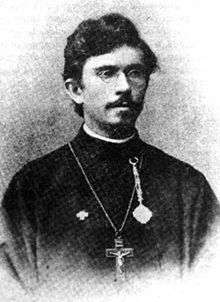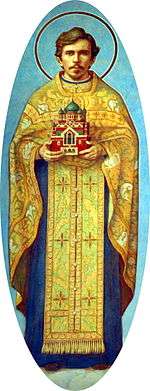Alexander Hotovitzky
| Saint Alexander Hotovitzky | |
|---|---|
 Photograph taken before 1909. | |
| Missionary and Hieromartyr | |
| Born |
February 11, 1872 Kremenetz, Volhynia, Russia |
| Died | August 19, 1937 (aged 65) |
| Canonized | 1994 |
| Feast | December 4 (Day of glorification as a saint) |
Saint Alexander Hotovitzky (or Hotovitsky), hieromartyr of the Bolshevik yoke, Missionary of America, was a Ukrainian who came to the United States in the 1890s as a lay missionary and was ordained to the priesthood while there. He was active as a missionary among the emigrated Uniates in the northeastern United States before being ordered back to Europe 1914. He was to become vicar of the congregation of the Russian Embassy in Berlin. Because of the outbreak of the First World War he was instead made vicar of the Orthodox congregation in Helsinki, Finland, then a part of imperial Russia. In 1917 he was assigned to Christ the Savior Cathedral in Moscow. After the Bolshevik coup he was subjected to many cruelties by the revolutionaries as he defended the Orthodox faith, his people, and church property. Subjected to many arrests and exile Father Alexander serviced his beloved Church as best he could through these tumultuous times until after a final arrest he was executed during the Great Purge on August 19, 1937. His glorification is celebrated on December 4.
Missionary in the United States

Alexander Hotovitzky was born on February 11, 1872, in the city of Kremenets in Volhynia (now Ukraine). His father, Alexander, was a priest who was the rector of the Volhynia Theological Seminary. Fr. Alexander was educated at the Volhynia Seminary before entering the St. Petersburg Theological Academy. Upon graduation from the academy in 1895 with a master's degree he was sent to the Diocese of the Aleutians and North America as a lay missionary and as reader at the St. Nicholas Church in New York City. He was ordained a deacon after his marriage to Maria Scherbuhina, who was a graduate of the Pavlosk Institute of St. Petersburg. Bishop Nicholas Ziorov ordained Fr. Alexander to the priesthood on February 25, 1896, at the diocesan cathedral in San Francisco.[1]
A week later he returned to New York to become the pastor of St. Nicholas Church (New York, NY), where he had been a reader. During the ensuing years, Fr. Alexander was successful in his missionary activities among the emigrees from Galicia and Carpatho-Russia as well as representing the Orthodox Church before American religious institutions and meetings.[2] He was instrumental in the establishment of many new Orthodox parishes, including those in Yonkers, Passaic, Philadelphia, and Watervliet.[3]
He edited the journal of Orthodox activity, the American Orthodox Messenger. He actively participated in establishing an Orthodox mutual aid society (ROCMAS), including serving in various management positions. Through his initiative and active participation, a new architecturally majestic St. Nicholas Cathedral was built to replace the small parish church in New York City. He traveled throughout the United States, and even to Russia, soliciting funds for its construction. Tzar Nicholas contributed 5,000 rubles.[4] In 1903, the new edifice became the diocesan cathedral.
The treaty to end the Russo-Japanese war was negotiated through the initiative of President Theodore Roosevelt. The negotiations and signing took place in Portsmouth, New Hampshire. Fr Alexander was among the Orthodox clergy who traveled to Portsmouth for the occasion, where a service of Thanksgiving was held in Christ Church. Archpriest Fr. Alexander sang a solemn "Te Deum"; also participating were choristers from St. Nicholas Cathedral.[5]
For eighteen years he served in America under Bishop Nicholas; the future Patriarch of Moscow, St. Tikhon; and Archbishop Platon; the now Archpriest Alexander was recalled to Russia on February 26, 1914.[1]
Russia and Martyrdom
After his arrival in Russia Fr. Alexander was appointed rector of the Orthodox congregation in Helsinki; then a part of the Russian Empire.[1] Here, as assistant to the archbishop of Finland, Sergius (Stragorodsky), later Patriarch Sergius I of Moscow, he defended the Orthodox minority against the proselytizing activities of the expansionist Finnish Lutherans. The crypt chapel of the Uspenski Cathedral in Helsinki is today named after him. Then in August 1917 he was transferred to Christ the Savior Church in Moscow as an assistant priest to once again serve under his old archpastor from America, the future St. Tikhon.
He also arrived as two historic events were to unfold, the All-Russian Church Council of 1917-1918 and the Bolshevik coup of October 1917. He was an active participant in the Church Council and assisted St. Tikhon in the administration of the Moscow diocese. With the loss of state funding, the Church and the Cathedral had to look to other sources of funds. Fr. Alexander, with Fr. Nicholas Arseniev, the rector of Christ the Savior Cathedral, aided the establishment of a brotherhood that appealed to the Orthodox flock to defend and preserve the Cathedral, and to aid the starving.
Fr. Alexander's activities defending the Church naturally brought upon him the enmity of the Bolsheviks and led to his arrest for brief periods in May 1920 and November 1921 for violating decrees concerning church relationships. In 1922, the next stage of Bolshevik antagonism began as Church property, including icons and sacred vessels, were confiscated on the pretext of helping the poor and starving. Although St. Tikhon encouraged the Church's donation of funds for this purpose, this was not enough for the Bolsheviks. So, St. Tikhon issued a decree based on canon law that the clergy in Russia were not to surrender sacred vessels for non-ecclesiastical use. This brought St. Tikhon's arrest and numerous court trials in which the servants of the Church were accused of counter-revolutionary activity. These trials intensified the Bolshevik attacks and the increased shedding of blood of the clergy and faithful who defended God's Church.
| This article forms part of the series | |||
| Orthodoxy in the Americas | |||
|---|---|---|---|
 | |||
| History | |||
| People | |||
| Jurisdictions (list) | |||
|
Other |
|||
| Monasteries | |||
| List | |||
| Seminaries | |||
|
|
|||
| Organizations | |||
|
Active Defunct |
|||
Fr. Alexander was in the forefront of those who implemented the Patriarch's instructions. He took part in meetings to draft a resolution for a general parish meeting of Christ the Savior parish about the state decrees. This resolution, drafted by Fr. Alexander, was presented at a general meeting of the parish by Archpriest Nicholas Arseniev on March 23, 1922. Fr. Alexander had already been placed under arrest. The final resolution contained demands of guarantees from the state that all donations from the Church would be used for saving the lives of the starving. However, the drafting of this resolution was considered a further example of counter-revolutionary activity. This led to further trials and executions of hieromartyrs and martyrs. Then a new high-visibility trial was convened in Moscow on November 27, 1922, during which 105 clergy and laity were accused of "attempting to retain in their hands possession of church valuables and, through the resulting starvation, to topple the Soviet Regime."
In this trial the state prosecution portrayed Fr. Alexander as a central figure in the activities surrounding the preparation of the resolution. Under questioning, Fr. Alexander did not admit to wrongdoing and tried to protect the other defendants. In his final words as a defendant, Fr. Alexander defended the meeting as an ordinary meeting without any counter-revolutionary intent. On December 13, 1922, the verdicts were announced. As a surprise the penalties were milder than earlier bloody verdicts.[2] Fr. Alexander and two others were given ten-year sentences in prison, loss of their personal property, and loss of civil rights for five years. The others were given lesser sentences, but appeals for pardons were turned down by the Supreme Central Executive Committee on February 16, 1923.
Then, surprisingly, in October 1923, Fr. Alexander and others were granted amnesty. However, despite his freedom he was not assigned to a parish but served by invitation in Moscow churches. Then on September 4, 1924, the State Political Directorate recommended administrative exile of thirteen clergy and church leaders including Fr. Alexander. After further interrogation, Fr. Alexander was exiled to the dreaded northern Turuhan region for three years. After his return from exile, he was elevated to the rank of protopresbyter and was assigned as an assistant to the Deputy Locum-Tenens of the Patriarchal Throne, Metropolitan Sergius. In the 1930s, he went on to serve as rector of the Church of the Deposition of the Robe on Donskoy Street.
Then in the summer of 1937, Fr. Alexander was again arrested. He was sentenced to death, and shot on August 19, 1937, and buried in the Donskoi cemetery.
Veneration
Fr. Alexander Hotovitsky is celebrated in the Russian and Greek Orthodox Churches on December 4.[6]
References
- 1 2 3 "New-Hieromartyr Alexander Alexandrovich (Hotovitsky)", Holy Trinity Cathedral
- 1 2 Glorification of the Priestmartyr Alexander Hotovitzky
- ↑ "Parish Background", St.Basil's Russian Orthodox Church, Watervliet, new York
- ↑ "History of Saint Nicholas Cathedral", Russian Orthodox Church in the United States of America
- ↑ "Christ Church Service", Portsmouth Peace Treaty
- ↑ Greek Orthodox Archdiocese of America
See also
Sources
- Alexis Liberovsky, Ed., The Life of Saint Alexander Hotovitzky, New Hieromartyr of Russia, Missionary to America, Alive in Christ, 1995-2, (Fall 1995).
External links
- Icon of St. Alexander Hotovitzky
- New-Hieromartyr Alexander Alexandrovich (Hotovitsky) including "Speech Delivered at the Ordination of Priest Alexander Hotovitsky"
- Father Alexander Hotovitsky including photograph
- Russian priest present for signing of Portsmouth treaty
- St Hotovitsky's Article on Orthodoxwiki
- Хотовицкий Александр Александрович, St. Tikhon's University database of new martyrs